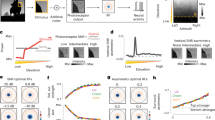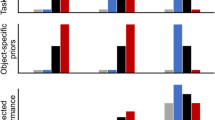Abstract
The human visual system is capable of making spatial discriminations with extraordinary accuracy. In normal foveal vision, relative position, width or size can be judged with an accuracy much finer than the size or spacing of even the smallest foveal cones. This remarkable accuracy of spatial vision has been termed ‘hyper-acuity’1. Almost a century ago Ewald Hering proposed that the accuracy of Vernier acuity could be accounted for by averaging of discrete samples along the length of the lines comprising the targets2; however, the discovery that Vernier acuity of a few arc seconds could be achieved with dots has rendered the nature and role of sampling in spatial discrimination unclear3. We have been investigating the sampling of spatial information in central and peripheral vision (the perifovea) of normal human observers and in observers with strabismic amblyopia. Our results, presented here, show that peripheral vision and central vision of strabismic amblyopes differ qualitatively in their sampling characteristics from those of the normal fovea. Both the periphery and the central visual field of strabismic amblyopes demonstrate marked positional uncertainty which can be reduced by averaging of spatial information from discrete samples.
This is a preview of subscription content, access via your institution
Access options
Subscribe to this journal
Receive 51 print issues and online access
$199.00 per year
only $3.90 per issue
Buy this article
- Purchase on Springer Link
- Instant access to full article PDF
Prices may be subject to local taxes which are calculated during checkout
Similar content being viewed by others
References
Westheimer, G. Invest. Ophthal. vis. Sci. 12, 570–572 (1975).
Hering, E. Ber. Math. phys. Classe Königl Sachs Ges. Wiss Leipzig (Naturwiss. Teil) 16–24 (1899).
Ludvigh, E. Am. J. Ophthal. 36, 139–142 (1953).
Levi, D. M., Klein, S. A. & Aitsebaomo, A. P. Vision Res. 25, 963–977 (1985).
Levi, D. M. & Klein, S. A. Vision Res. 25, 979–991 (1985).
Braddick, O. Nature 298, 224–225 (1982).
Hess, R. & Bradley, A. Nature 287, 463–464 (1980).
Westheimer, G. & McKee, S. P. Vision Res. 17, 940–967 (1977).
Dow, B. M., Snyder, R. G., Vautin, R. G. & Bauer, R. Expl. Brain Res. 44, 213–228 (1981).
Author information
Authors and Affiliations
Rights and permissions
About this article
Cite this article
Levi, D., Klein, S. Sampling in spatial vision. Nature 320, 360–362 (1986). https://doi.org/10.1038/320360a0
Received:
Accepted:
Issue Date:
DOI: https://doi.org/10.1038/320360a0
This article is cited by
-
Characterising the orientation-specific pattern-onset visual evoked potentials in children with bilateral refractive amblyopia and non-amblyopic controls
Documenta Ophthalmologica (2021)
-
Visual crowding is a combination of an increase of positional uncertainty, source confusion, and featural averaging
Scientific Reports (2017)
-
Undercounting features and missing features: evidence for a high-level deficit in strabismic amblyopia
Nature Neuroscience (2000)
-
Neural computation of inner geometric pattern relations
Biological Cybernetics (1986)
Comments
By submitting a comment you agree to abide by our Terms and Community Guidelines. If you find something abusive or that does not comply with our terms or guidelines please flag it as inappropriate.



